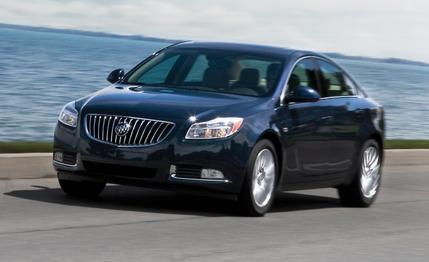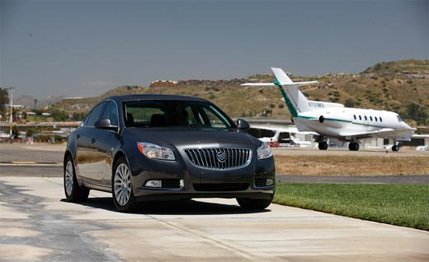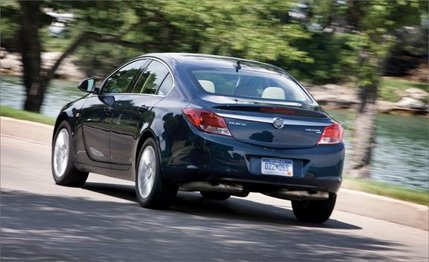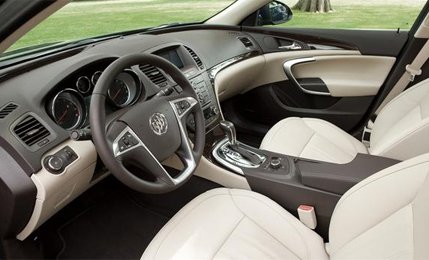
 Road Test
Road Test
When a recent invite to drive the on the 12.9-mile Nürburgring pavement roller coaster in Germany hit our inbox, we checked the calendar to make sure it wasn’t April 1st. A Buick at the Nürburgring? Good one.Buick Regal
It was actually late April, and the Regal is actually extremely composed—even at the renowned Ring, where it spent engineering time during its development. Firm, but with lots of compliance to soak up even the roughest pavement. Sorry, longtime Buick demographic, floating is no longer on the menu. The steering strikes a similarly competent balance of solid on-center feel for excellent directional stability without forgetting about turn-in response.


But is it a sports sedan? Buick officials are a little too eager to label their front-drive Acura TSX fighter just that. All that compliance in the suspension is great for ride quality, but it means that the Regal isn’t as buttoned down or connected as are true, rear-drive sports sedans. And although 0.85 g on the skidpad is commendable considering the Michelin M+S tires, why did Buick insist on switching from the Euro cars’ summer rubber? And the sporty intentions aren’t helped at all by a mushy brake pedal.
Still, the Regal continues an encouraging upswing for Buick, started by the very credible Enclave crossover and LaCrosse sedan. Just a few years ago, you’ll remember, the brand was casting aimlessly for greater appeal and sportiness, doing things like dropping the 300-hp, transverse LS4 small-block V-8 into the previous-gen LaCrosse to create the 156-mph Super model. It was a soft, torque-steering handful.
Developed in Germany on Epsilon II architecture at Opel, the Regal represents GM’s first truly global-car program. The car is essentially a shorter-wheelbase version of the LaCrosse and is sold as the Opel/Vauxhall Insignia in Europe and as a Regal in China. However, it was originally planned to be the now-defunct Saturn Aura in the U.S., which is why it’s just now available here when it’s been on sale elsewhere since late 2008.
All variants share taut sheetmetal and a handsome interior that includes standard leather seats. Although the seats are comfortable, with good thigh support, they are not as enveloping as the TSX’s, and the bolstering is more of a relaxed fit than we’d specify. But the biggest letdown inside is the frumpy, GM-parts-bin blue-green display in the cluster.
For 2011, U.S. Regals will be imported from Opel’s factory in Rüsselsheim, Germany, and will be available only in uplevel $26,995 CXL trim. Even with everything—navigation, sunroof, a Harman/ Kardon stereo, a power passenger seat—our test car rang in at $31,780, which is on a par with a base TSX. Other newfangled safety gear that generally tends toward annoying, such as blind-spot and lane-departure warning systems, isn’t available on the Regal, which is fine by us. But where are the HID headlamps?
Next year, production shifts to Oshawa, Ontario, and presumably there will be further decontented models, although trim-level designations (CX, CXL, CXS) will disappear altogether.


At a time when many vehicles in the family-sedan pack have gotten too large—how many Honda Accord buyers really need space to haul five six-foot-plus adults simultaneously?—the Regal strikes us as decidedly right-size. Back-seat space is very reasonable; the limiting factor is headroom, pinched by the cascading roofline. In that regard, the Regal comes up an inch shy compared with the swoopy new Hyundai Sonata, although the overall rear volume is identical due to the Buick’s almost three additional inches of legroom.
On the road, the Regal has an impressively solid and refined feel and is exceptionally quiet at speed. However, all of its polish is no doubt enabled by its substantial 3681-pound curb weight, a sticking point on many of GM’s recently overhauled vehicles. That’s more than 200 pounds heftier than the TSX and comparable to an Audi A4 laden with an iron-block engine and all-wheel drive.
Which brings us to even more bad news: The Regal’s excellent though heavy chassis is let down by its base powertrain. The 182-hp, 2.4-liter direct-injection four-cylinder falls 19 horses short of the TSX’s port-injected 2.4—granted, that one takes premium fuel— and 18 short of Hyundai’s DI 2.4-liter, which doesn’t. Plus the Regal’s torque peak sits at an elevated 4900 rpm, making the most potent part of the power band the narrow zone between that point and its 6500-rpm redline. A redline, you’ll notice, that is actually 200 rpm below the engine’s power peak (the fuel cutoff doesn’t come in until 7000 rpm, however, but the transmission shifts well shy of that anyway). Plus, it’s not nearly as engaging as the honking Acura engine, and during steep uphill sections of the Nürburgring, or even at highway speeds, acceleration is discerned more by engine racket than actual thrust. And the transmission, while smooth, could be more prompt, particularly during wide-open-throttle upshifts and while using the manumatic function. Use of the latter becomes necessary during enthusiastic driving because, otherwise, upshifts happen the instant the driver backs off the throttle.


When pressed about this, Buick types tend to mention “responsible performance.” We have another term for the Regal’s ordinary horsepower and substantial heft: slow. Accelerating to 60 mph in 8.7 seconds puts the Regal at the plodding end of the four-cylinder family-sedan crowd and well off the luxury pace. Even fuel-economy ratings— 19 mpg city and 30 highway— are clobbered by the similarly sized Sonata (22 city and 35 highway) and bettered by the larger and 58-hp stronger BMW 528i, too. Spending the extra $2500 for the optional 220-hp, 2.0-liter turbo, which is also available paired to a decent six-speed manual, should hasten the Regal to base TSX territory. An even higher state of tune for that powerplant will accompany a future performance variant, the Regal GS.
By Buick’s math, before the Regal came along, the nameplate’s lineup of two rather large sedans and one behemoth ute competed in segments that comprised just 14 percent of the U.S. market, sales-wise. Come 2012, after a Chevy Cruze–based compact sedan and a small crossover are added, that figure will leap to 46 percent.
Even so, last year Buick astonishingly outsold Audi, Infiniti, and Lincoln in the U.S. To date, which includes no significant sales of the appealing Regal, Buick’s numbers are trending higher than all those, plus Acura. Surprising? You bet. Deserved? More than ever.